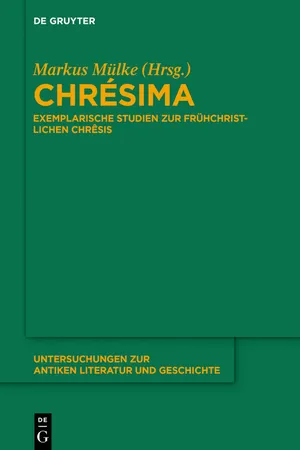
- 374 Seiten
- German
- PDF
- Über iOS und Android verfügbar
Über dieses Buch
Those cultural assets of the ancient world that the fathers of early Christianity recognised as usable according to the standard of Christian truth, they liked to call ???????. Their ?????? (Chrêsis; Latin: usus iustus) itself, i.e. the method of diacritical judgement and selective use, was not only practised in practice, but was also repeatedly thought through theoretically, without ever turning it into an abstract concept detached from the concrete object. Anyone researching chrêsis, one of the decisive forces of that world-changing transformation that represents the transformation of ancient culture into early Christian culture, therefore always starts from the exploration of a ????????.
Early Christian chrêsis has received particular attention in recent research, not least due to the studies of Christian Gnilka. However, meaningful individual studies in which the principle of usus iustus in praxi is proven and demonstrated are urgently needed. This volume aims to fulfil this desideratum and the authors have dedicated the contributions to Christian Gnilka on the occasion of his 80th birthday in December 2016. The value of his research approach is also demonstrated by the fact that the studies presented here cover the entire period of early Christianity up to late antiquity (from the Apologists to the Cappadocians, Jerome, Augustine and Prudentius), starting with an Old Testament text, and also deal with archaeological and art-historical monuments in addition to literature.
Häufig gestellte Fragen
- Elementar ist ideal für Lernende und Interessierte, die gerne eine Vielzahl von Themen erkunden. Greife auf die Elementar-Bibliothek mit über 800.000 professionellen Titeln und Bestsellern aus den Bereichen Wirtschaft, Persönlichkeitsentwicklung und Geisteswissenschaften zu. Mit unbegrenzter Lesezeit und Standard-Vorlesefunktion.
- Erweitert: Perfekt für Fortgeschrittene Studenten und Akademiker, die uneingeschränkten Zugriff benötigen. Schalte über 1,4 Mio. Bücher in Hunderten von Fachgebieten frei. Der Erweitert-Plan enthält außerdem fortgeschrittene Funktionen wie Premium Read Aloud und Research Assistant.
Bitte beachte, dass wir keine Geräte unterstützen können, die mit iOS 13 oder Android 7 oder früheren Versionen laufen. Lerne mehr über die Nutzung der App.
Information
Inhaltsverzeichnis
- Inhalt
- Vorwort
- Chrêsis in der Bibel
- Der theologische Gebrauch aramäischer Verwaltungsterminologie im Danielbuch
- Christliche Apologeten
- Wie man pagane Geschichtsschreibung ad maiorem Dei gloriam verwendet: Der Altersbeweis in Tatians Rede an die Griechen
- Lo „gnostico“ e Chrêsis secondo Clemente Alessandrino
- Qualche osservazione su krisis e „giusto uso“ della cultura pagana in Tertulliano
- Vom Verlierer zum Vorbild: M. Atilius Regulus in der antiken Geschichtsschreibung und christlichen Apologetik
- Kappadokier
- Fantasie pagane e immaginazione cristiana nella teologia cappadoce
- Hieronymus
- Auf Studienreise? Apollonius von Tyana und Paulus bei Hieronymus (epist. 53, 1–3 an Paulinus)
- Augustinus
- „Verstehst Du auch, was Du liest?“ Möglichkeiten und Grenzen der Bibelexegese nach Augustinus
- Usus iustus e „monoteismo pagano“. Suggestioni storico-religiose a partire da Augustinus doctr. 2, 40, 60
- La correlazione uti-frui nel De civitate Dei di Sant’Agostino. Apporti filosofici da una controversia antica
- Socrates christianus: Augustinus als Dialektiker im Briefwechsel mit Longinianus (epist. 233–235)
- Christliche Dichtung
- Penthesileia – Camilla – Fides: Pagane Rezeption und christliche Nutzung
- Bildende Kunst
- I vescovi e l’uso del ritratto in età paleocristiana
- Spätantike und Mittelalter
- Omne quod vobis apponitur manducate. Speisegebote in der multireligiösen Gesellschaft der Spätantike und im christlichen Mittelalter
- Register